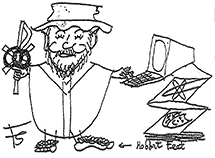The writer Charles Williams (friend of C.S.Lewis and J.R.R.Tolkien) was a brilliant and gifted interpreter of Scripture. In one of Jesus’ parables there is a wedding feast to which all are invited. But one man does not come in a wedding garment, and is not allowed in. Why?
Williams thinks that the feast is a metaphor for the heavenly ball and banquet hosted by God, and that the requirement is that each guest wear a joyful personality suitable to the wonder of heavenly entertainment. Joy is found in relationship: therefore what you wear must be something borrowed from someone else: our bare thorny egos must be transformed by graces, beauties, virtues and talents which we borrow from each other - taking the best from one another to adorn our selves! To create our selves.
So Williams writes a remarkable poem (in “The Image of the City” page 166). The invited guests are sent cards which say “Fancy Dress” and the proud pushy self-satisfied person who comes only in his own apparel is not let in. The Footman explains:
“Sir, tonight
is strictly kept as strictly given;
the fair equivalents of heaven
exhibit at Our Lord’s desire
their other selves, and all require
virtues and beauties not their own
ere genuflecting at the Throne.
In the joyful throng:
This guest his brother’s courage wore;
that, his wife’s zeal, while, just before,
she in his steady patience shone;
there a young lover had put on
the fine integrity of sense
his mistress used; magnificence
a father borrowed of his son,
who was not there ashamed to don
his father’s wise economy.
No he nor she was he or she
merely; no single being dared…
come without other kind of dress,
than his poor life had to profess
and yet those very robes were shown
when from preserval as his own
into another’s glory given,
bright ambiguities of heaven.”
We do not have to look far in the science of this world to see that borrowings are part of natural life: the replication of DNA in growth and reproduction is a story of repetition and innovation, something borrowed, some-thing new. Mitochondria in cells, which carry the female DNA through generations, were supposedly bacteria which found it to their interest to live within simpler cells. Symbiosis is the process by which separate organisms become attached to each other to work out cooperative and new existence. The common lichen we find on trees and rocks consists of two or more different organisms which live together successfully. From the borrowing of electrons to create the elements of the periodic table to the diversity of labour in anthills, bee hives and human societies, we find vive la difference as a chorus celebrating the bright ambiguities of the created order.
As above, so below : as below, so above.8

